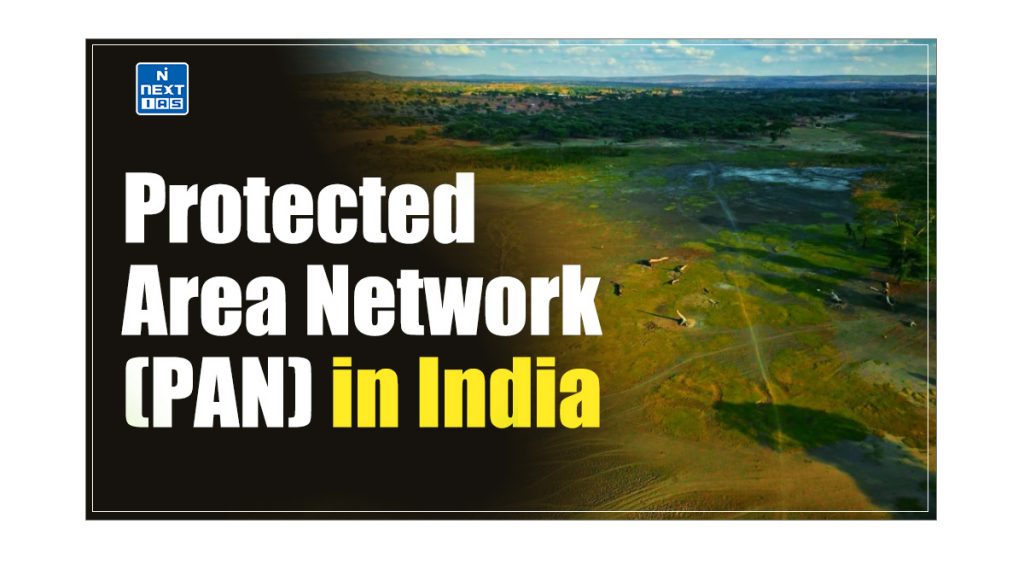
Protected Area Network (PAN) in India forms the cornerstone of the country’s biodiversity conservation strategies. Under this, a robust network of protected areas with varying regulations and objectives has been established across the country. This article aims to study in detail the Protected Area Network (PAN) in India, including National Parks, Wildlife Sanctuaries, Biosphere Reserves (BRs), Community Reserves, Conservation Reserves, and Sacred Groves among others.
What are Protected Areas?
- Protected Areas, also known as Conservation Areas, refer to the areas that are designated and managed with the specific goal of protecting ecosystems, conserving biodiversity, and providing long-term benefits to both wildlife and human communities.
- These areas play a crucial role in conserving natural habitats, maintaining ecological balance, and safeguarding threatened or endangered species.
- A group of Protected Areas, collectively, is referred to as the Protected Area Network (PAN).
IUCN’s Definition of Protected Area
IUCN defines a protected area as: “A clearly defined geographical space, recognised, dedicated, and managed, through legal or other effective means, to achieve the long-term conservation of nature with associated ecosystem services and cultural values.”
Protected Area Network in India
- Under the provisions of the Wildlife (Protection) Act of 1972, a robust Protected Area Network (PAN) have been established in India.
- Major categories of Protected Areas (PAs) coming under the Protected Area Network (PAN) in India include:
- National Park,
- Wildlife Sanctuary,
- Biosphere Reserve,
- Conservation Reserve,
- Community Reserve,
- Sacred Grove, and
- Coastal and Marine Protected Area.
Each category of these protected areas under the Protected Area Network in India has been explained in detail in the sections that follow.
National Park (NP)
- A National Park is a designated area set aside for the conservation of ecosystems, the protection of biodiversity, and the provision of opportunities for recreation and environmental education.
- They are established under the provisions of the Wildlife (Protection) Act of 1972.
- National Parks can be declared by both the central government and state governments.
- These areas are established in regions considered to have significant ecological, geomorphological, and natural importance, and forms one of the most important component of the Protected Area Network in India.
- The main objective of a national park is to safeguard & protect the natural environment of the area and conserve biodiversity.
- Their boundaries are fixed and defined.
- No alteration of the boundaries of a National Park (NP) can be made, except on a resolution passed by the State Legislature.
- They cannot be downgraded to the status of a ‘sanctuary’.
- A National Park (NP) has more restrictions as compared to a Wildlife Sanctuary.
- No human activities are allowed inside National Parks.
- Private tenurial rights and grazing of livestock are not permitted here.
- No person shall remove, destroy, or exploit any wildlife in a National Park (NP) or deprive any wild animal of its habitat or damage or destroy the habitat of any wild animal within a National Park (NP).
- At present, around 106 National Parks exist as part of the Protected Area Network in India.
- Some prominent examples of National Parks in India include – Jim Corbett National Park, Kaziranga National Park, etc.
Wildlife Sanctuary
- A wildlife sanctuary is a type of protected area that is designated for the conservation of wildlife species and their habitats.
- They are also established by the State Government under the provisions of the Wildlife (Protection) Act of 1972.
- A wildlife sanctuary is an area of nature owned by the Government or a private agency for the protection of particular species of flora or fauna during a part of the year or in its entirety.
- Unlike National Parks (NP), Wildlife Sanctuaries may permit certain human activities within their boundaries, as long as these activities do not substantially impact the well-being of the wildlife.
- Human activities like private ownership rights, harvesting of timber, and collecting minor forest products are allowed as long as they do not interfere with the well-being of animals.
- Boundaries of sanctuaries are not well defined, but controlled biotic interference is permitted.
- A number of Wildlife Sanctuaries have been established as part of the Protected Area Network in India, such as Mhadei Wildlife Sanctuary, Tamor Pingla Wildlife Sanctuary, etc.
Difference between National Park and Wildlife Sanctuary
- Although both National Park and Wildlife Sanctuary are aimed at the protection and development of wildlife, they differ in terms of regulations.
- The main difference between the two lies in terms of activities allowed within their areas.
- In a wildlife sanctuary, some other human activities may be allowed, whereas in a National park (NP), no other human activities are allowed.
- For instance, while people may have rights for timber extraction in a wildlife sanctuary, such rights are not granted within the boundaries of a national park.
Biosphere Reserves (BRs)
- A Biosphere Reserve (BR) is an area of terrestrial, marine and coastal ecosystems that promote the conservation of biodiversity with its sustainable use.
- Biosphere Reserves are integral components of the internationally recognized framework of UNESCO’s Man and Biosphere (MAB) programme initiated in 1971 and they are nominated by national Governments.
Read our detailed article on Biosphere Reserves (BRs).
Conservation Reserves
- Conservation Reserve refers to an area lying adjacent to national parks or wildlife sanctuaries, owned by the State Government adjacent, and is designated for protecting the landscape, seascape, and habitat of fauna and flora.
- These reserves are created under the Wildlife (Protection) Amendment Act of 2002.
- The State Government may designate and declare any area as a Conservation Reserve after having consultations with the local communities.
- It is managed by a Conservation Reserve Management Committee (CRMC).
- At present, more than 115 Conservation Reserves exist as part of the Protected Area Network in India.
- Prominent examples – Tiruppadaimarathur Conservation Reserve, Sorsan Conservation Reserve, etc.
Community Reserve
- A community reserve is a type of protected area that is established and managed by the local communities in collaboration with the government.
- The purpose of declaring such an area is to enhance the socio-economic conditions of the local communities while also conserving wildlife.
- These reserves were created under the Wildlife (Protection) Amendment Act of 2002.
- The state government may notify any private land or community land as a community reserve, provided that the individuals concerned or members of that community are agreeable to offering such areas for protecting the flora and fauna, as well as their traditions, cultures and practices.
- A Community Reserve is managed through a Community Reserve Management Committee.
- No change in land use pattern within a Community Reserve shall be made, except in accordance with a resolution passed by the Community Reserve Management Committee and approval of the same by the state Government.
- At present, there are around 220 Community Reserves as part of the Protected Area Network in India.
- Prominent examples: Keshopur Chamb Community Reserve, Gogabeel Community Reserve, etc.
Sacred Groves
- Sacred groves are patches of forest or natural vegetation, ranging from a few trees to several acres, typically dedicated to local deities (such as Ayyanar and Amman) or tree spirits (Vanadevatais).
- These areas are safeguarded by local communities due to their religious beliefs and traditional rituals passed down through generations.
- The degree of sanctity of the sacred forests varies from one grove to another.
- The sacred groves are important repositories of floral and faunal diversity and act as a rich gene pool, including rare, threatened and endangered species.
- These are categorised into various types, such as:
Traditional Sacred Groves
Traditional Sacred Groves are the places where the village deity resides, which is represented by an elementary symbol.
Temple Groves
Temple Groves are created around a temple and conserved, and groves around the burial or cremation grounds.
Coastal and Marine Protected Areas
- As defined by the IUCN, they refer to any area of intertidal or subtidal terrain, together with its overlaying water and associated flora, fauna, and cultural and historical features, that has been reserved by law or other effective means to protect part or all of the enclosed environment.
- They are aimed at protecting and conserving the natural marine ecosystems in their pristine condition.
- These areas focus on the marine reserves, which include underwater habitats such as wetlands, estuaries, wetlands, seagrass beds, etc.
- At present, there are around 31 Marine Protected Areas (MPAs) in India.
- Examples: The Gulf of Kachchh Marine National Park, Wandoor Marine National Park, etc.
Conclusion
Protected Area Network (PAN) in India contributes significantly to conserving the country’s rich biodiversity. In addition to conserving India’s wildlife and natural heritage, these areas play a crucial role in maintaining ecological balance and fostering sustainable development. Establishing such a robust Protected Area Network (PAN) in India showcases the country’s commitment to ensuring the coexistence of humans and nature and promoting sustainable development.
GS - 3





